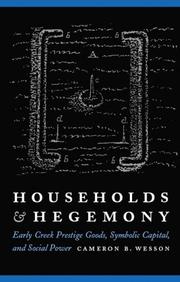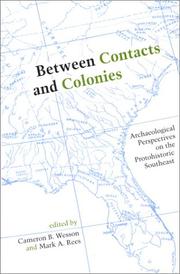| Listing 1 - 3 of 3 |
Sort by
|

ISBN: 1281241407 9786611241407 0803217803 9780803217805 9781281241405 9780803247956 0803247958 661124140X Year: 2008 Publisher: Lincoln : University of Nebraska Press,
Abstract | Keywords | Export | Availability | Bookmark
 Loading...
Loading...Choose an application
- Reference Manager
- EndNote
- RefWorks (Direct export to RefWorks)
Wesson demonstrates that change within Creek culture in the historic period was shaped by small-scale social units and individual decisions rather than by the effects of larger social and political events. Households and Hegemony enriches our understanding of Creek history and makes a key contribution to comparative archaeological models of cultural change.
Excavations (Archaeology) --- Households --- Indians of North America --- Creek Indians --- Population --- Families --- Home economics --- American aborigines --- American Indians --- First Nations (North America) --- Indians of the United States --- Indigenous peoples --- Native Americans --- North American Indians --- Maskoki Indians --- Muscogee Indians --- Muskogee Indians --- Muskoki Indians --- Mvskoke Indians --- Mvskokvlke --- Five Civilized Tribes --- Muskogean Indians --- History. --- First contact with Europeans --- Politics and government. --- Social life and customs. --- Culture --- Ethnology --- Alabama --- Antiquities. --- First contact with other peoples
Book
ISBN: 1282520059 9786612520051 0810863391 9780810863392 0810868237 9780810868236 9780810868236 Year: 2009 Publisher: Lanham, Md. : Scarecrow Press, Inc.,
Abstract | Keywords | Export | Availability | Bookmark
 Loading...
Loading...Choose an application
- Reference Manager
- EndNote
- RefWorks (Direct export to RefWorks)
The indigenous populations of North America created impressive societies, engaged in trade, and had varied economic, social, and religious cultures. Over the past century, archaeological and ethnological research throughout all regions of North America has revealed much about the indigenous peoples of the continent. This book examines the long and complex history of human occupation in North America, covering its distinct culture as well as areas of the Arctic, California, Eastern Woodlands, Great Basin, Great Plains, Northwest Coast, Plateau, Southwest, and Subarctic. Complete with maps, a ch
Indians of North America --- American aborigines --- American Indians --- First Nations (North America) --- Indians of the United States --- Indigenous peoples --- Native Americans --- North American Indians --- History --- Culture --- Ethnology --- North America --- Turtle Island (Continent)

ISBN: 081738474X 9780817384746 081731167X 9780817311674 0817312536 9780817312534 Year: 2002 Publisher: Tuscaloosa : University of Alabama Press,
Abstract | Keywords | Export | Availability | Bookmark
 Loading...
Loading...Choose an application
- Reference Manager
- EndNote
- RefWorks (Direct export to RefWorks)
This collection of essays brings together diverse approaches to the analysis of Native American culture in the protohistoric period. For most Native American peoples of the Southeast, almost two centuries passed between first contact with European explorers in the 16th century and colonization by whites in the 18th century-a temporal span commonly referred to as the Protohistoric period. A recent flurry of interest in this period by archaeologists armed with an improved understanding of the complexity of culture contact situations and important new theoretical paradigms
Indians of North America --- Antiquities --- History --- Southern States
| Listing 1 - 3 of 3 |
Sort by
|

 Search
Search Feedback
Feedback About UniCat
About UniCat  Help
Help News
News